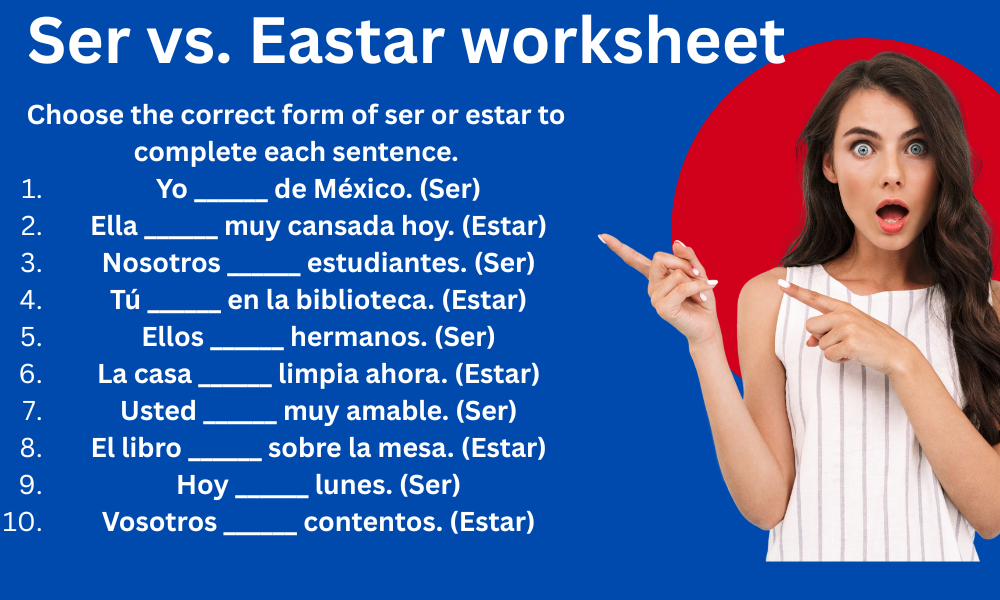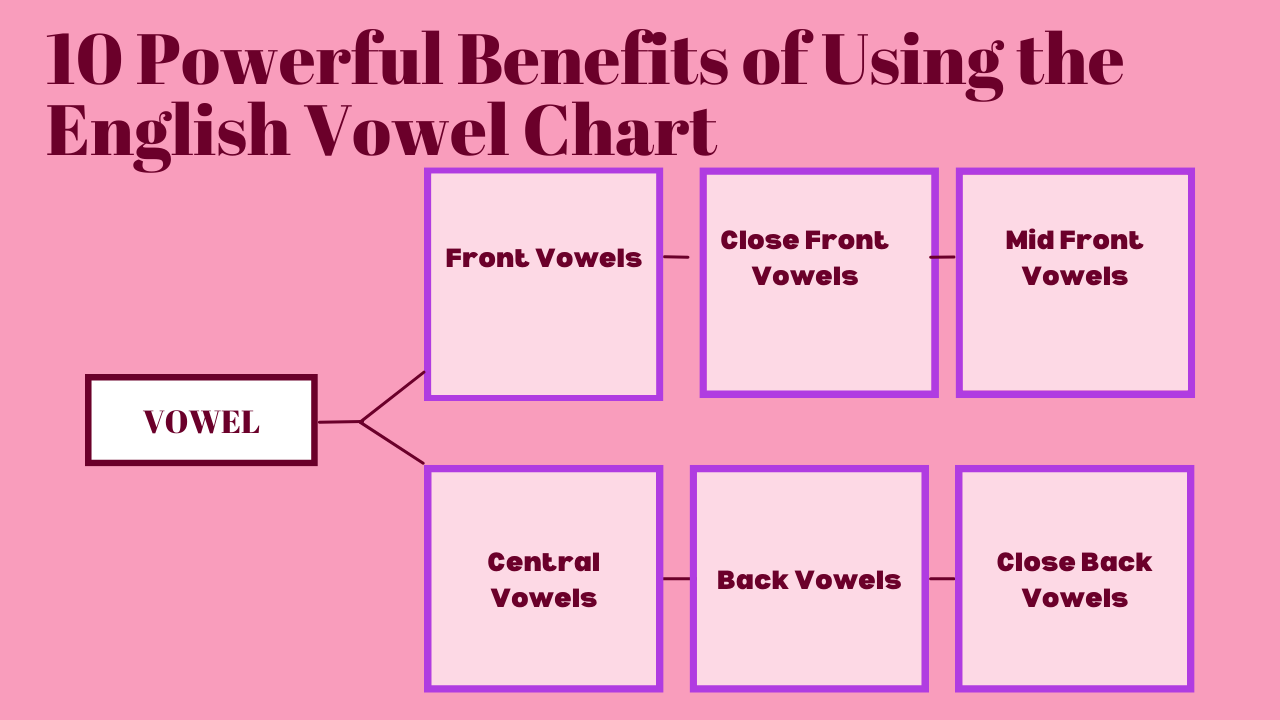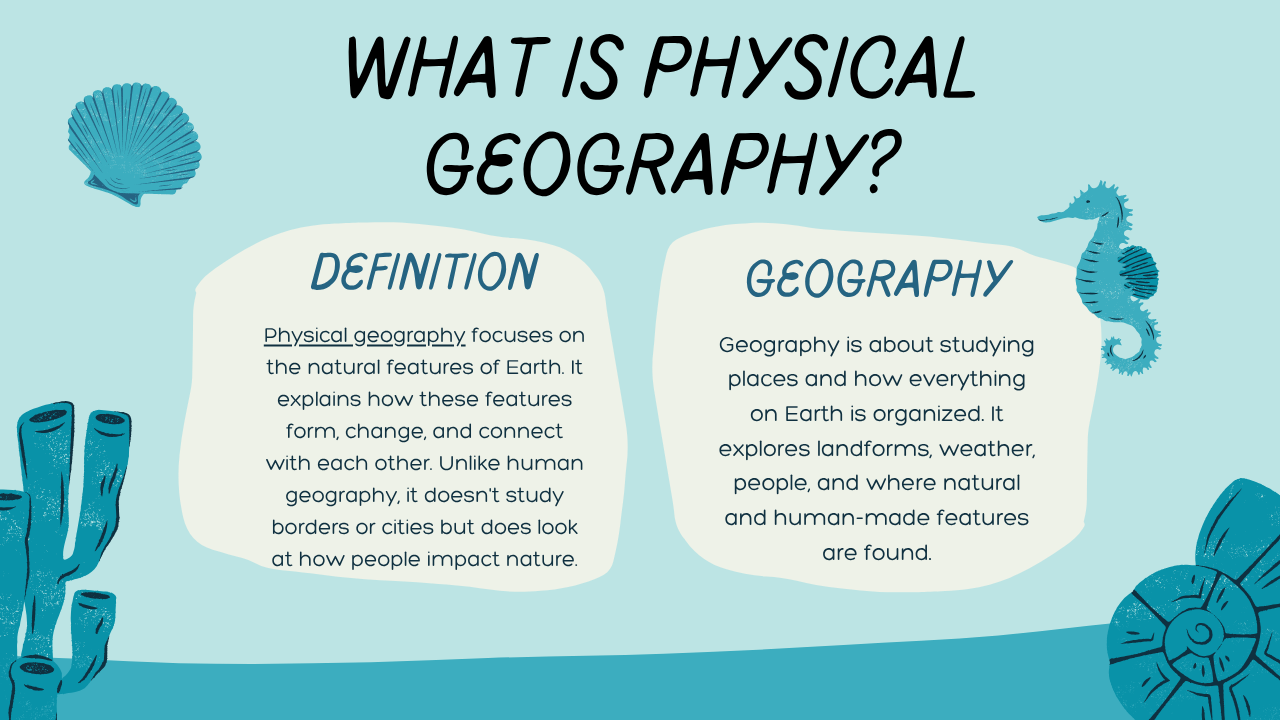If you’re learning Spanish, you’ve come across the tricky topic of ser vs estar. Both verbs mean “to be,” but they’re used in different situations, and it’s one of the most common areas of confusion for beginners. That’s why getting a good understanding of ser vs estar early on can make a big difference. In this guide, we’ll walk you through simple rules and real-life examples to help you learn when and how to use each verb correctly.
Whether you’re describing a person, a location, or even your mood, knowing the difference between ser vs estar helps you sound more natural and confident when speaking Spanish. And if you ever feel stuck, don’t worry — personalized support is just a click away. With the help of an online tutor, you can master topics like ser vs estar faster and with less frustration.
✅ Ser vs Estar: Use Ser When Something Is Permanent or Part of Identity
1. Who are you?
Soy Sajid. → I am Sajid.
2. What do you do?
Ella es profesora. → She is a teacher.
3. What someone/something is like:
Él es alto y simpático. → He is tall and friendly.
4. Where someone is from:
Somos de USA → We are from USA.
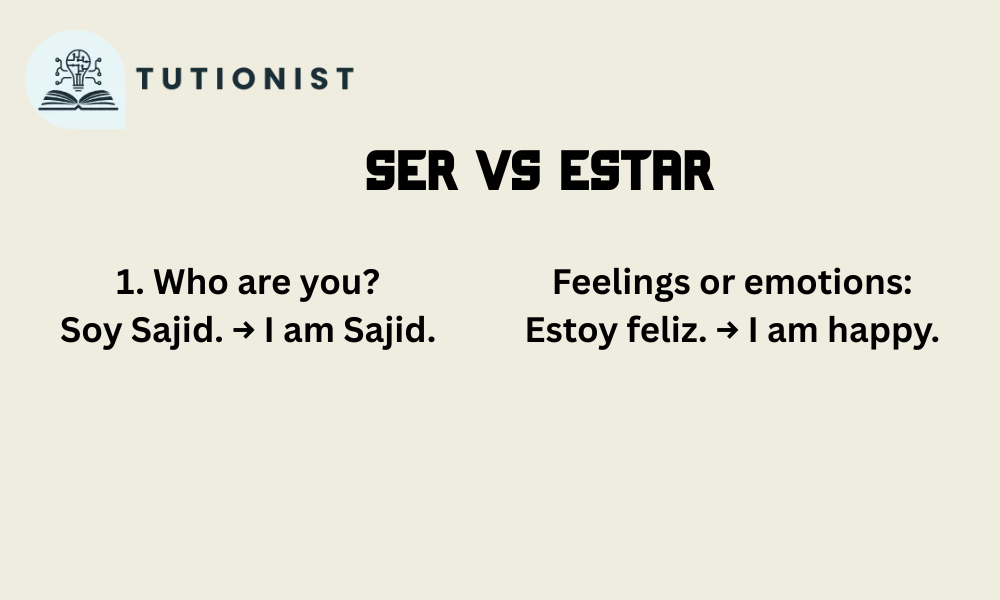
✅ Use estar when something is temporary or can change:
Feelings or emotions:
Estoy feliz. → I am happy.
Location:
Estamos en casa. → We are at home.
Current actions:
Está estudiando. → He is studying.
Physical state:
La sopa está caliente. → The soup is hot (right now).
When to Use Ser in Spanish – Part of the Ser vs Estar Guide
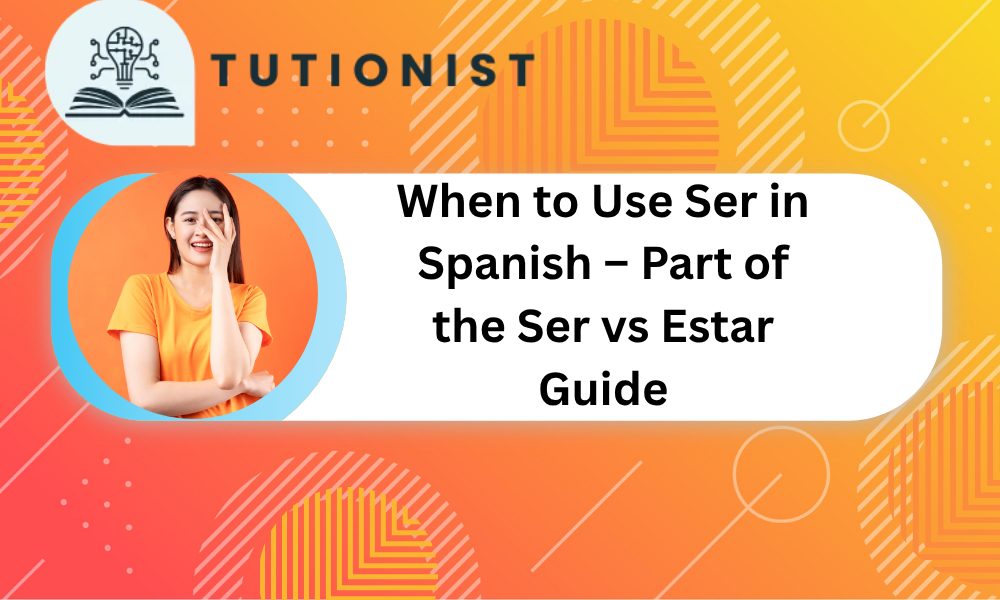
The verb ser is used when you’re talking about things that are permanent or that define what something is at its core. Think of it as the go-to verb for describing identity, facts, and unchanging characteristics.
Here are some of the most common times to use ser:
- To identify a person or thing
- Ella es Ana. (She is Ana.)
- To describe basic qualities or traits
- El coche es rojo. (The car is red.)
- To say where someone is from (nationality or origin)
- Somos de México. (We are from Mexico.)
- To talk about professions
- Soy profesor. (I am a teacher.)
- To express religious or political beliefs
- Son católicos. (They are Catholic.)
- To tell time, days, or dates
- Hoy es lunes. (Today is Monday.)
- To show possession
- Es mi libro. (It’s my book.)
- To say what something is made of
- La mesa es de madera. (The table is made of wood.)
- To describe relationships
- Él es mi hermano. (He is my brother.)
🔹 When to Use Estar in Spanish – Part of the Ser vs Estar Guide
Now let’s look at estar, the other half of the ser vs estar pair. While ser is all about identity and permanence, estar is used to describe how someone or something is right now, in terms of mood, health, actions, or location.
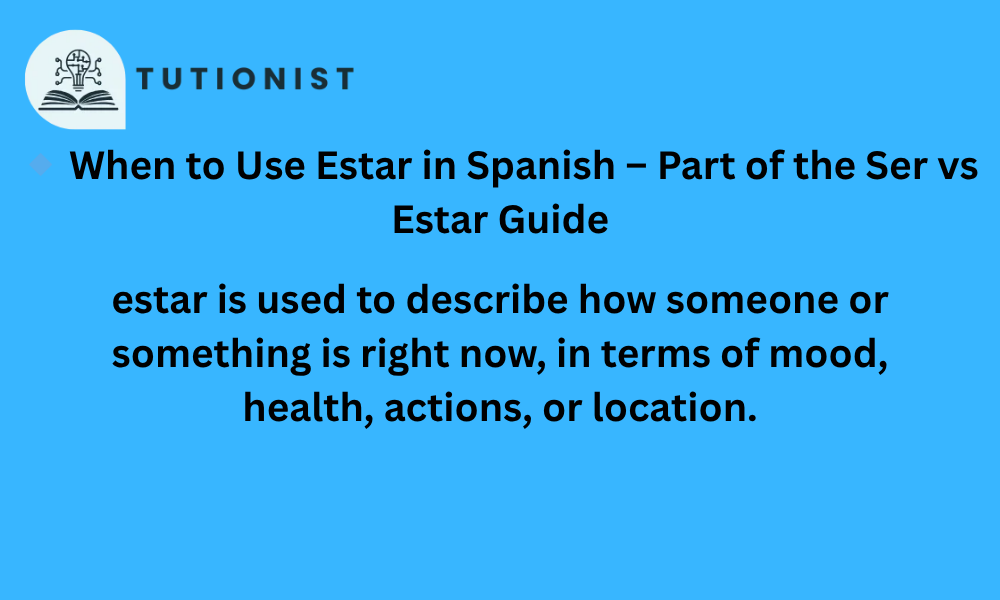
Think of estar as the how someone or something is, rather than what it is.
Here are some of the most common uses of estar:
- 📍 To show location
- → Estamos en casa. (We are at home.)
- 🧠 To describe conditions or temporary states
- → Está cansado. (He is tired.)
- → La sopa está fría. (The soup is cold.)
- 🔄 To form the present progressive (-ing)
- → Estoy estudiando. (I am studying.)
- 🗣️ To use in common expressions
- → Estar de buen humour (to be in a good mood)
- → Estar de acuerdo (to agree)
🔤 Ser Conjugation – Singular
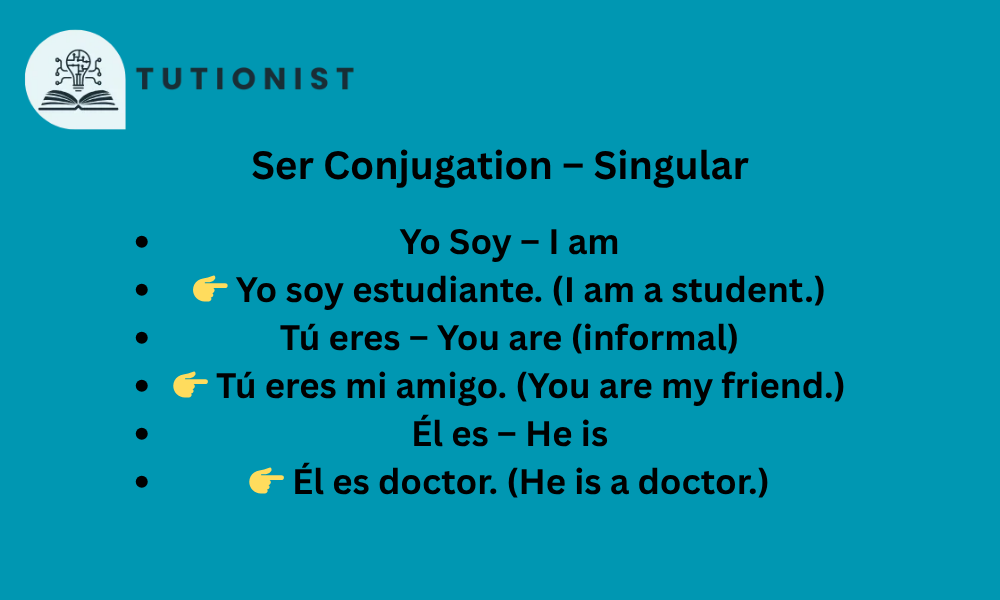
Here’s how to use ser in the present tense when talking about one person:
- Yo Soy – I am
- 👉 Yo soy estudiante. (I am a student.)
- Tú eres – You are (informal)
- 👉 Tú eres mi amigo. (You are my friend.)
- Él es – He is
- 👉 Él es doctor. (He is a doctor.)
- Ella es – She is
- 👉 Ella es amable. (She is kind.)
- Usted es – You are (formal)
- 👉 Usted es muy profesional. (You are very professional.)
🔤 Ser Conjugation – Plural
Now let’s look at how to use ser in the present tense when talking about more than one person:
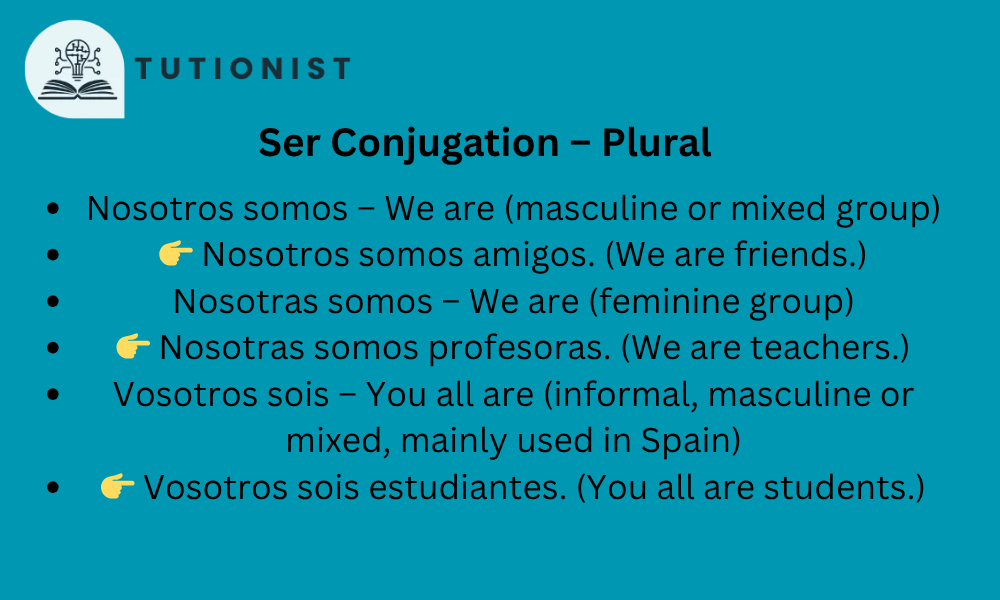
- Nosotros somos – We are (masculine or mixed group)
- 👉 Nosotros somos amigos. (We are friends.)
- Nosotras somos – We are (feminine group)
- 👉 Nosotras somos profesoras. (We are teachers.)
- Vosotros sois – You all are (informal, masculine or mixed, mainly used in Spain)
- 👉 Vosotros sois estudiantes. (You all are students.)
- Vosotros sois – You all are (informal, feminine, used mainly in Spain)
- 👉 Vosotras sois inteligentes. (You all are smart.)
- Ellos son – They are (masculine or mixed group)
- 👉 Ellos son hermanos. (They are brothers.)
- Ellas son – They are (feminine group)
- 👉 Ellas son amigas. (They are friends.)
- Ustedes son – You all are (formal in Spain, informal and formal in Latin America)
- 👉 Ustedes son bienvenidos. (You all are welcome.)
📘 Ser Conjugation – Singular Forms
Form Used For Explanation Example
Soy First-person singular. Used when you’re talking about yourself. Yo soy estudiante.
(I am a student.)
Eres Second-person singular Used when talking to one person you know well. Tú eres mi amigo.
(You are my friend.)
Third-person singular Used when talking about someone or being formal, Ella es doctora.
(She is a doctor.)
Usted es amable.
(You are kind – formal)
🔄 Adjectives That Change Meaning with Ser vs Estar
Some adjectives in Spanish can mean different things depending on whether you use ser (for permanent traits) or estar (for temporary states). Here’s a quick guide:
AdjectiveWith Ser – Meaning & ExampleWith Estar – Meaning & Example
Listo Clever / smart
➡️ Él es listo. (He is clever.) Ready
➡️ Él está listo. (He is ready.)
Bueno, Good person/kind
➡️ Jorge es bueno. (Jorge is a good person.) Attractive or in good shape
➡️ Jorge está bueno. (Jorge looks good.)
Aburrido Boring
➡️ Elena es aburrida. (Elena is boring.) Bored
➡️ Elena está aburrida. (Elena is bored.)
Malo Bad / mean
➡️ Antonio es malo. (Antonio is a bad person.) Sick
➡️ Antonio está malo. (Antonio is sick.)
Rico Rich (money)
➡️ El rey es rico. (The king is rich.) Tasty/delicious
➡️ La comida está rica. (The food is tasty.)
Seguro Safe / secure
➡️ Aquí soy segura. (Here I feel safe.) Sure / certain
➡️ No estoy segura. (I’m not sure.)
📝 In Conclusion: Ser vs Estar Made Simple
In this guide, we explored the key differences between ser and estar, two Spanish verbs that both mean “to be” but are used in very different ways. To make it easy to remember, here’s a quick summary chart you can come back to anytime:
📊 Ser vs Estar – Quick Comparison Chart
Here’s the information organized into a clear table format:
| Ser (Used for…) | Example | Estar (Used for…) | Example |
|---|---|---|---|
| Identity (Permanent) | Soy Juanita. (I’m Juanita.) | — | — |
| Description (What something is like) | El computador es caro. (The computer is expensive.) | Physical/Emotional States | Estoy mareada. (I’m dizzy.) |
| Occupation / Nationality | Soy enfermera. (I’m a nurse.) | — | — |
| Ideology, Beliefs, and Values | Soy ambientalista. (I’m an environmentalist.) | — | — |
| Relationships (Family/friend connections) | Soy la hermana de Susana. (I’m Susana’s sister.) | — | — |
| Origin / Material / Possession (Ser + de = where from, made of, or belongs to) | Soy de Lima. (I’m from Lima.) | — | — |
| Time / Day / Date | Hoy es lunes. (Today is Monday.) | — | — |
| — | — | Temporary Situations (Short-term or changing conditions) | Este día está ocupado. (This day is busy.) |
| — | — | Location (Where people or things are) | Mi mamá está en la oficina. (My mom is in the office.) |
| — | — | Place (Where a city or place is) | Madrid está en España. (Madrid is in Spain.) |
✅ Final Tip:
Remember this rule of thumb:
- Ser = What something is (permanent)
- Estar = How something is (temporary)
You’re now one step closer to mastering one of the trickiest parts of Spanish grammar!
FAQs
Q. What is the difference between Ser and Ester?
Ans. The verb ser is used when you’re talking about permanent things, and estar is used to describe how someone or something is right now, in terms of mood, health, actions, or location.
Q. What is the trick for ser vs estar?
To remember the difference between ser and estar, think of two acronyms: DOCTOR for ser and PLACE for estar. Use ser for permanent things: Description, Occupation, Characteristics, Time, Origin, and Relationship. Example: Ella es doctora (She is a doctor). Use estar for temporary or changing situations: Position, Location, Action, Condition, and Emotion. Example: Estoy feliz (I’m happy). A quick tip: Use ser for what something is, and estar for how something is.
Q. When to use eres and estas?
Ans. “Eres” is used for permanent situations, like personality or identity, while “estás” is used for temporary conditions, like mood or location.
Q. Is age ser or estar?
Ans. Age usually uses ser because it’s seen as a permanent trait.
For example: El perro es viejo (The dog is old) describes the dog’s character, not just a moment.
But if you’re talking about someone looking older temporarily, estar can be used.
Q. What are 5 sentences using ser?
Ans. 1. Who are you?
Soy Sajid. → I am Sajid.
2. What do you do?
Ella es profesora. → She is a teacher.
3. What someone/something is like:
Él es alto y simpático. → He is tall and friendly.
4. Where someone is from:
Somos de USA → We are from USA.
5.Él es alto. He is tall.
Q.Is health ser or estar?
Health is usually expressed with estar because it refers to a temporary condition.
👉 Example: Estoy enfermo. (I’m sick.)
👉 Example: ¿Cómo estás? (How are you?) – often asking about health or mood.
Q.When to use IR?
Here are the most common ways to use it:
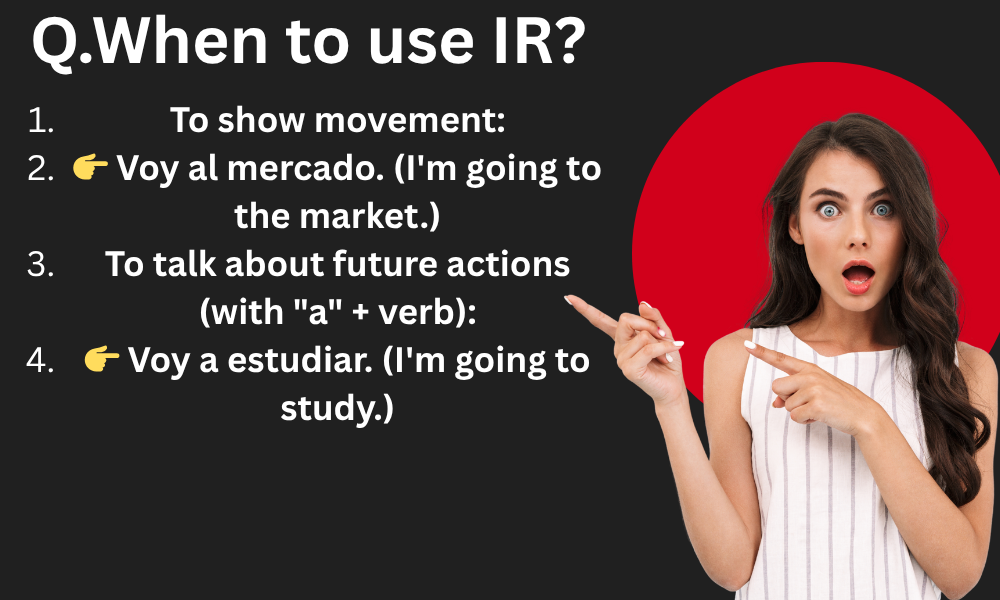
- To show movement:
- 👉 Voy al mercado. (I’m going to the market.)
- To talk about future actions (with “a” + verb):
- 👉 Voy a estudiar. (I’m going to study.)
- To show progress or changes:
- 👉 Va mejorando. (It’s getting better.)
- Sometimes, to describe how someone looks:
- 👉 Vas muy elegante hoy. (You look very elegant today.)
Q. When to use ser, estar, and tener?
Ana. We use these three verbs in different situations:
Use tener to talk about what you have or in special expressions.
Example: Tengo doce años. (I’m 12 years old.)
Even though it means “to have,” it’s also used for age, hair, or feelings like Tengo frío (I’m cold).
Use ser to describe permanent traits or identity.
Example: Mi pelo es rubio. (My hair is blonde.)
This verb is for things that don’t usually change, like appearance, origin, or profession.
Use estar for temporary conditions or feelings.
Example: Estoy bien. (I’m well.)
It’s used for mood, health, or location.
Q. When to use imperfect vs preterite?
Ans. We use the preterite tense for completed actions in the past — things that happened once or had a clear beginning and end.
👉 Ayer comí pizza. (I ate pizza yesterday.)
We use the imperfect tense for ongoing or repeated past actions, or when the start and end times aren’t clear.
👉 Cuando era niño, comía pizza todos los domingos. (When I was a child, I used to eat pizza every Sunday.)
So, think of preterite = one-time, finished actions, and imperfect = habits or ongoing past situations.
Q. Is viejo ser or estar?
Ans. Usually, “viejo” (old) is used with ser, because age is seen as a more permanent characteristic.
Q.When to use Haber?
Ans. Use haber in two main ways:
- To say “there is” or “there are”
- 👉 Hay un libro en la mesa. (There is a book on the table.)
- To form past tenses (like “have eaten”)
- 👉 He comido. (I have eaten.)
It’s not used for people directly — it just helps talk about existence or past actions.
Q. How do I know if it’s ser or estar?
Ans. Ser = what something is
Estar = how or where it is
Q. Do you have a Ser vs estar chart?
Ans. ✅ Ser vs Estar – Quick Reference Chart
Here’s the information organized into a clear table format:
| Category | Ser (Permanent) | Estar (Temporary) |
|---|---|---|
| Description | Ella es alta. (She is tall.) | |
| Occupation | Soy profesor. (I’m a teacher.) | |
| Characteristics | Él es amable. (He is kind.) | |
| Time & Date | Hoy es lunes. (Today is Monday.) | |
| Origin / Nationality | Somos de Chile. (We are from Chile.) | |
| Relationships | Es mi hermana. (She is my sister.) | |
| Location | Estoy en casa. (I’m at home.) | |
| Health / Feelings | Está enfermo. (He is sick.) | |
| Emotions | Estoy feliz. (I’m happy.) | |
| Ongoing Actions | Estamos estudiando. (We are studying.) | |
| Conditions | La sopa está caliente. (The soup is hot.) |
This table clearly distinguishes between the uses of Ser (for permanent or inherent traits) and Estar (for temporary states or conditions).
Q. Can you give the Ser vs. Eastar worksheet
Ans. Part 1: Fill in the Blank
Choose the correct form of ser or estar to complete each sentence.
- Yo ______ de México. (Ser)
- Ella ______ muy cansada hoy. (Estar)
- Nosotros ______ estudiantes. (Ser)
- Tú ______ en la biblioteca. (Estar)
- Ellos ______ hermanos. (Ser)
- La casa ______ limpia ahora. (Estar)
- Usted ______ muy amable. (Ser)
- El libro ______ sobre la mesa. (Estar)
- Hoy ______ lunes. (Ser)
- Vosotros ______ contentos. (Estar)
Part 2: Translate
Translate the following sentences into Spanish, using ser or estar.
- I am a teacher.
- She is at the park.
- We are happy.
- The apple is red.
- They are from Spain.
Part 3: Correct the Errors
Some of these sentences use ser or estar incorrectly. Correct the mistakes.
- Ella está doctora.
- Nosotros somos en la escuela.
- Tú eres cansado.
- El cielo es azul.
- Ellos están estudiantes.
Part 4: Create Your Own
Write 5 original sentences using ser and estar correctly.
Answer Key (for self-checking):
Part 1:
- soy
- está
- somos
- estás
- son
- está
- es
- está
- es
- estáis
Part 2:
- Soy profesor/profesora.
- Ella está en el parque.
- Estamos felices.
- La manzana es roja.
- Son de España.
Part 3:
Ellos son estudiantes
Ella es doctora.
Nosotros estamos en la escuela.
Tú estás cansado.
El cielo es azul. (correct)
